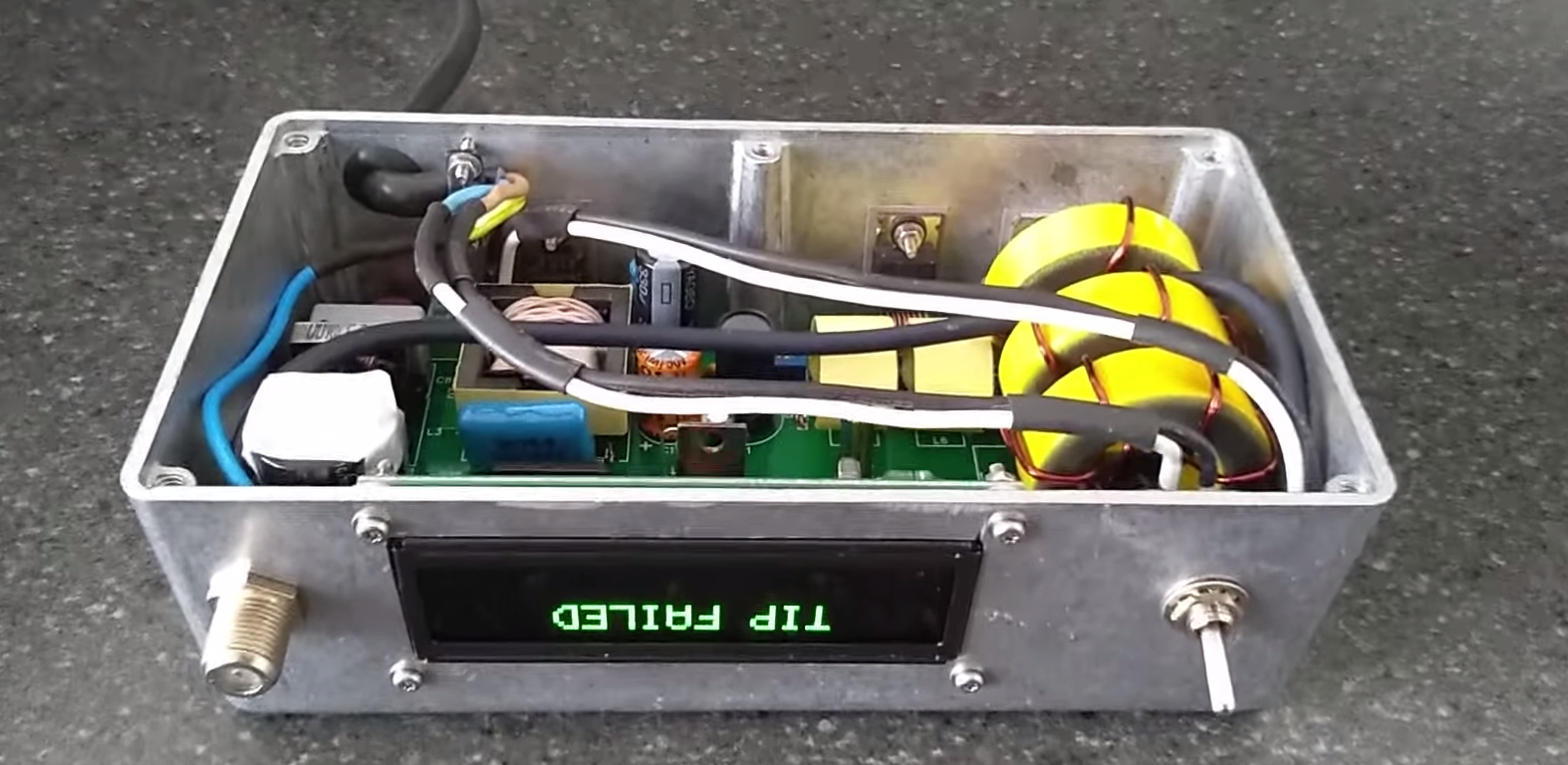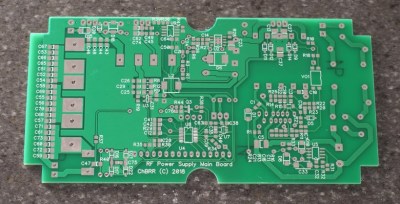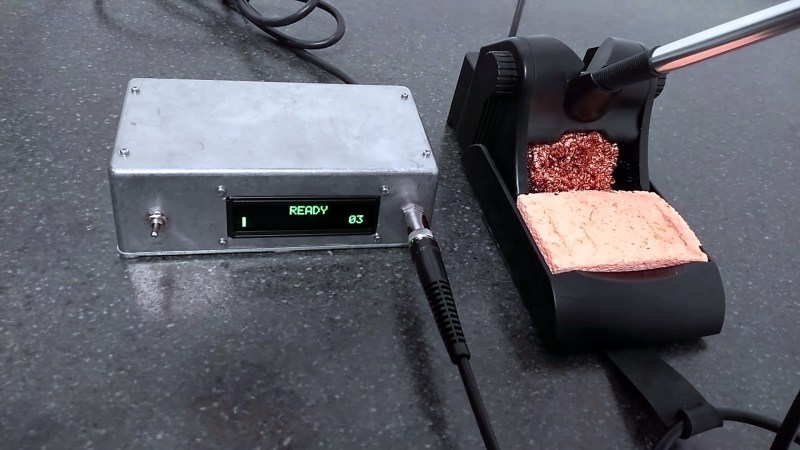First soldering irons are often of the Radioshack or Maplin firestarter variety. They’re basically wall power shorted across a nichrome heater or similar with some inline resistance to make it harder to burn down the house. You plug them in, the current flows, and they get hot. Done.
If you stick with the hobby for a while, these eventually get replaced with something like the venerable HAKKO FX-888D or that one Weller everyone likes with the analog knob. These are much improved; having temperature control leads to a more consistently heated tip and much improved soldering experience.
Entering the electronics workplace one comes across the next level of quality soldering iron: high end HAKKOs, Metcals, JBCs, and the like. Using one of these irons is practically a religious experience; they heat in a flash and solder melts while you blink. They even turn off when you put the handpiece down! But they’re expensive to buy (hint: think used). What’s a hobbyist to do?

[SergeyMax] seems to have had this problem. He bit the bullet, figured out how the Metcal works, and made his own base. This is no mean feat as a Metcal might look like a regular iron but it’s significantly more complex than ye olde firestarter. The Metcal magic is based on a oscillating magnetic fields (notice the handpiece is connected via BNC?) interacting with a tip bearing a special coating. In the presence of the changing field the tip heats up until it hits its Curie temperature, at which point it stops interacting with the magnetic field and thus stops heating.
When the user solders, the tip cools by sinking its heat into the part and drops below the Curie temperature again, which starts the heating again. It’s like temperature control with the sensor placed absolutely as close to the part as possible and a nearly instant response time, without even a control loop! [SergeyMax] has a much more thorough description of how these irons work, which we definitely recommend reading.

So what’s the hack? Based on old schematics and some clever reverse engineering from photos [SergeyMax] built a new base station! The published schematic is as rich with capacitors and inductors as one could hope. He didn’t post source or fab files but we suspect the schematic and photos of the bare board combined with some tinkering are enough for the enterprising hacker to replicate.
The post contains a very thorough description of the reverse engineering process and related concerns in designing a cost efficient version of the RF circuitry. Hopefully this isn’t the last Metcal replacement build we see! Video “walkthrough” after the break.
Edit: I may have missed it, but eagle eyed commentor [Florian Maunier] noticed that [SergeyMax] posted the sources to this hack on GitHub!
Thanks for the tip Freddie!
















I started using Metcals when they first came out, and have never looked back. Luckily, the companies I worked at were all willing to buy them, and then I bought a couple MX-500 bases on a real deal for my personal use. Deals can be found on eBay, for sure.
I always hear this and no one ever says why, I have used metcal’s and have never found them special.. even to the point of “why does this thing cost THAT much” its good but for the money they kind of suck
I would like to see a comparison of the TS100 (which uses an integrated resistive heater) to a Metcal or similar that uses induction heating. I predict induction would win but by not as much of a margin as compared to the older soldering irons.
TS-100 seems to have the resistive heating element quite far from the tip. In my experience, it loses to Metcal a lot, especially with small diameter tips Metcal pushes out much more heat to the PCB.
But I have used better resistive heating element irons than TS-100, and the difference to inductive is not that big.
Similar experience here. Work used to have a Metcal, and it was always a bit of a pig to use, even compared to a temperature controlled Hakko clone. I bought a JBC for personal use, and that truly was a transcendental experience.
JBC IMO is a better choice if one is to dump some money on an iron
I’m not sure where “suck” comes from. I also haven’t ever used a JBC, so I’ll limit my comments to what I like about the Metcal.
1) Cartridge tips — quick change, huge selection (I’ve got some really esoteric ones I’ve acquired over the years).
2) Low-mass handles — unlike many of the Wellers, the wand is extremely light, doesn’t transmit heat to your fingertips during extended periods of holding the wand, and a very flexible feed line.
3) Fast heat — Metcals are ready to solder in under 10 seconds for almost all tips (some of the really chunky ones, like for removing QFP-144s take longer). Turn it off, grab the tip with the rubber mat, pull it out, and stick a new tip in, and you’re back soldering in 10 seconds. Wellers, like the WTCPT, require unscrewing the metal retainer to remove the tip. You either wait for it to cool, or you use pliers. No bueno.
4) MX-500 dual-port. I have two MX-500 bases, three wands, and a pair of Talon tweezers. I keep a heavy tip in one, a typical through-hole part tip in one, and SMT tip in the 3rd one. The MX-500 has an A/B switch, so I just throw the switch to select either the heavy tip or the through-hole tip on one unit, and the SMT or tweezers on the other.
5) LOTS of heat. The MX-500 is a 50 watt equivalent iron. With the heavy tip, I can solder a stack of 5 pennies to a piece of double-clad. Yet wit the SMT tip, I can do 0402 parts (maybe 0201 if I could see them :) ).
Part of the reason I’ve always stuck with Metcals and haven’t tried others like the JBC is because I have a lot of experience and investment in them. I actually bought and sold tips and power supplies on eBay for a while, about 10 years ago. I have a couple Metcal power meters for checking the power output, tips that require two power supplies to use (they’re novelty tips now, no one does QFP-144’s anymore), spare wands, spare bases, etc. Kind of like switching from Nikon to Canon because Canon came out with a feature you might use once a year, if you remember it’s there. They’re both good cameras.
The original PSU and the PS-30 should be avoided. They’re prone to failure and Metcal doesn’t repair them anymore. I’ve used at least 20 different MX-500s and never had one fail yet. Not saying they don’t, just hasn’t happened to me.
I agree in all those points, but we now use the ‘Thermaltronics’ clones. I find their iron tips to actually be nicer to use and they’re compatible with the Metcal base stations.
Are those wand-level or PSU-level compatible? I’ve heard the name, haven’t checked into them.
When the patents on the curie point heating technology expired ~10 years ago several Metcal (OK Industries) folks left and formed Thermaltronics. Most of their cartridges, handsets, and base units are compatible with Metcal stuff. I picked up a couple of the TMT-2000S stations on eBay for cheap a couple of years ago. Solid quality, every bit as good a Metcal.
I’ve bought two for less than 100 USD Each, Honestly though, I prefer the JBC tools, but if anyone wants a good, cheap, professional iron I always recommend looking for a 2nd hand metcal.
Here’s an earlier DIY Metcal supply : https://www.eevblog.com/forum/projects/diy-metcal-13-56-mhz-rf-supply/
I bought a few of those old cheap metcals and they are fantastic when they work but they seem to die after a year or two. I eventually bit the bullet and bought a hakko Fox-100 and it has proven way more durrable. I’m sure the newer metcals are better but damn are they expensive.
A battery operated Metcal would be nice for field use. Looks like it should be fairly easy to take the design and replace the mains supply with a 6S lipo.
Awesome hack.
JBC all the way for me. For small jobs the Weller WD1 tiny iron was already a revelation but even compared to that, the JBCs trump everything Hot in a second or so. crazy
I used metcals at a previous job, and have a dumpster-dived JBC at home. I much prefer the JBC.
It is the work that you do, not the tool that you use. Truthfully I would be weary of a soldering iron that requires a lot of electronics to function. IMHO this is just gratuitous electronics and asking for problems.
I look around me at any appliance that replaced an on and off switch with electronics and I see the dependability has gone down, in some cases drastically. We had computerized coffee machines at work that broke down on a weekly basis. The SO replaced a 30+ YO washer and drier set with machines that would feel at home on the space shuttle, they need to be fed expensive new parts annually. It seems they finally have the timers in microwave ovens and coffee makers somewhat down, but god help you if you get a new stove with all digital controls. The oven died (off) on mine, one friend had the oven die on with no thermal control, and another friend lost the use of half of his burners. He has an inexpensive induction hot plate sitting next to his fancy new stove. I have a nice DeWalt router that the soft start / speed controller has crapped out in. I would rather have a one speed functional router…
IMHO there are places that need tech, and you are better off applying the tech to them than screwing around with problems that have already been efficiently and inexpensively resolved.
It sounds like you have never used a decent soldering station that employs a micro controller to regulate the temperature of the iron tip. The Weller 936 that so many love: the common fail on those is not the electronics, it’s the bore on the tip not being drilled to the correct diameter or a crap heater element. In my experience only Hakko and Aoyue sell good tips and elements for those irons, the rest are a crap shoot on whether they are sized correctly. Many don’t even list if the elements they sell are ceramic or nylon (the nylon elements melt the first time you touch a large ground plane with the tip).
Complex and cheap(ly manufactured) don’t go well together. But I’m way too much of a geek to shun complex electronics altogether. And as a diy enthusiast, where’s the fun in having devices that never fail? ;-)
The electronics in itself is not the issue with the modern machines breaking shortly after the warranty runs out.
While devices that were built 30-40-50 years ago were built to last, these days the modern devices are built to be as cheap as possible and increase the returns for the shareholders. Unfortunately achieving the two and maintaining quality and durability of the product is a fight were the two later tend to be sacrificed.
There is sufficient understanding of the technologies involved, so the only reason for things to break is when cost cutting is involved.Thankfully some countries are introducing legislation for manufacturer’s warranty to cover the product for a minimum of 5 years, which should help on the durability side, but there are also manufacturers such as Miele, that give you 20 years warranty, but for a higher price compared to the rest.
This is awesome. Big kudos to SergeyMax for the sharing his work!
I bought an MX-500 a few years ago, and the seller told me that this is a soldering iron everything else is just a thing which has a hot tip :D.
Over the years I have started to agree with him. :D
Actually the source files for this are available there: https://github.com/SergeyMax/SolderingStation
Great find! I added a note to the post.
” (notice the handpiece is connected via BNC?) ”
No I noticed a different type of connector!
The original ones where a screw-on F-59 connector. The new ones are a quick-disconnect F-59. Same connector you find on TVs, cable boxes, etc.
Easybraid makes the curie heat style soldering irons compatible with the Metcal line. IIRC, one of the original designers left Metcal and went to Easybraid to design the iron and “fix” some of the previous design flaws.
Easybraid is no longer manufacturing soldering stations or tips, or so says their website.
Since you’re only using one handpiece wouldn’t it be easier to just copy the original MX-500P-11 circuit? I imagine the performance is the same?